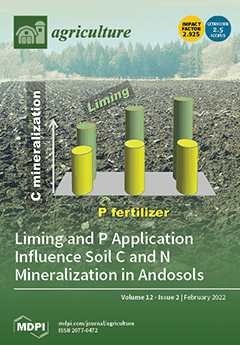Due to the increasing biomass of biowaste it is necessary to manage it rationally. This work presents comparisons and valorization of vermicomposts (VCs) and composts (Cs) prepared from various biowastes generated in households and private gardens, in terms of their practical use. The tested VCs and Cs were subjected to chemical analyses to assess the amounts of macro- (N, P, K, S, Mg, Ca, Na) and micronutrients (Fe, Zn, Mn, Cu, Ni), as well as contents of organic matter (OM), total organic carbon (TOC), humic compounds (HS) and labile and water extractable organic carbon (LC, WEOC). Moreover, humification indexes (HR, HI, DP) were determined. The amounts of macro- and micronutrients, OM, TOC, LC, WEOC were greater for vermicomposts. Regardless of these differences, both vermicomposts and composts were characterized by considerable amounts of organic matter ranging from 325 to 631 g·kg
−1 and TOC amounting from 82 to 270 g·kg
−1. Moreover, the tested organic fertilizers were characterized by high contents of N (7–21.5 g·kg
−1), K (3.7–24.4 g·kg
−1), Ca (12.2–44.0 g·kg
−1), Fe (133.1–333.8 mg·kg
−1) and Mn (71.5–113.8 mg·kg
−1). The analyzed VCs and Cs did not exceed the permissible amounts of heavy metals (Cr, Pb) and contained a comparable amount and quality of humus compounds. The level of C
HS ranged from 29.6 to 41 g·kg
−1 for vermicomposts, and from 19.8 to 51.8 g·kg
−1 for composts. The humification indexes indicate that VCs and Cs were well–matured despite different composting conditions. The HI values for VCs ranged from 8.3% to 10% and for Cs amounted from 12.2% to 16.8%. Similarly, the HR values were higher for composts (24.3–33%) in comparison to VCs (15.2–20.1%). Vermicomposting and composting of biowaste is economically and environmentally justified. Fertilizers obtained in the composting process are a valuable source of organic material and nutrients essential for plants and can be safely used in private gardens.
Full article





